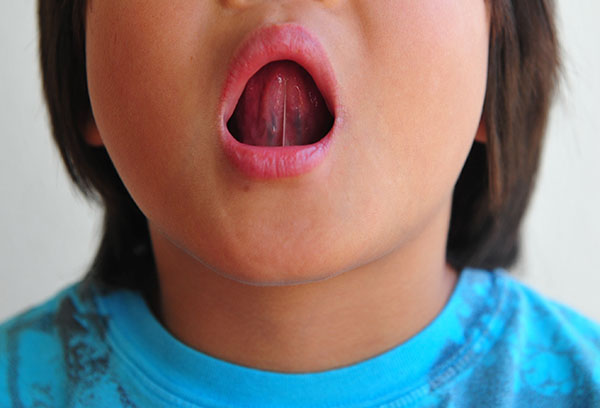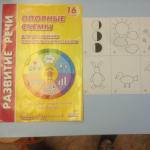A set of articulation exercises for setting sound l
Problems with the pronunciation of the letter L are quite common. The reasons can be either a delay in speech or psychoverbal development, or simple imitation (the child first spoke the sound correctly, and then went to kindergarten, where many children pronounce it incorrectly, heard enough of them and also began to pronounce the sound [l] with a defect). In this case, [l] can be replaced with something similar to the sound [v] or [j], or simply skipped when speaking. To help a child learn how to pronounce a sonorant sound correctly, articulation gymnastics exercises can be used to accurately and clearly set the sound [l].
What is articulation gymnastics?
The set of articulation exercises proposed below is aimed at setting and practicing the exact pronunciation of the sound [l]. They can be performed starting from the age of 2, when the child can already do what adults ask him to do.
These exercises must be performed in front of a mirror so that the baby can see what he is doing, and he can correctly respond to the comments of adults when he is corrected. The best effect from classes can be obtained if they are carried out in an easy game form.
All these exercises are aimed at achieving the desired articulation when pronouncing the letter L.
In order for the letter to sound correctly, the child's speech organs must take the following position.
- Lips slightly open, in a neutral position.
- The teeth are slightly open (about 3-4 mm).
- The tip of the tongue should be narrow and rest against the upper incisors, while the sides and middle part of the tongue should be lowered.
- In this case, the air jet should exit into the gap formed between the molars and the lateral edges of the tongue.
- The sound is produced by straining vocal cords.
In order for the baby to be able to clearly reproduce the sound, articulation gymnastics should be aimed at achieving the following effects:
- strengthening the muscles of the tongue;
- fixing its lifting to the desired position;
- stretching of the hyoid frenulum;
- development of mobility of the anterior part of the tongue;
- acquiring the skill to make the tip of the tongue sharp and tense;
- the ability to keep the articulation setting of all organs for a long time;
- the ability to quickly change the position of the tongue in the mouth for further correct articulation when consonants and vowels are combined in speech.
By the way, for the letters R and L, the exercises are in many ways similar, only for R it is important to work out the vibration of the tongue.
So that the articulation exercises for the sound [l] do not tire the baby and give the desired result, the duration of the classes should not exceed 15 minutes at the age of 3-4 years and 25 minutes if the child is 5-6 years old.

A set of articulation exercises
So, there are special exercises for the correct setting of the sound [l] in young children. It is important that the baby begins to perform them in a good mood, not through force, but as if by chance, so that he does not perceive it as a lesson.
- "Harmonic". On the lips - a smile, the mouth is parted. Suck with a wide tongue to the palate. Now you need, without releasing your tongue, slowly close-open your mouth (gradually stretching the hyoid frenulum), trying to gradually increase the amplitude. At the same time, the lips should not move, and the tongue should not sag.
- "Mushroom". In many respects it is similar to the previous one, but differs in statics: the tongue needs to be put only in the upper stretched position and held for several seconds (the mouth does not close). The lips should be fixed in a smile.
- "Turkey". The mouth is slightly open. The tongue must remain wide. It should be put in this state on the upper lip. Now it needs to be licked, gently stroking the tongue in the direction back and forth. In this case, the tongue cannot be torn off. Begin the exercise slowly, then gradually increase the speed. At the end, you need to add a voice to the lick (repeated sounds “bl” are obtained, reminiscent of turkeys). During the exercise, the tongue should remain wide and smoothly lick the upper lip, but not be pushed forward, but move back and forth without swinging from side to side.
- "Horse". Smile with your mouth wide open. Next, you need to raise the wide tongue up, “glue” it to the palate, then slowly tear it off, lowering it down. You should get a sound similar to the clatter of hooves. Gradually increase the execution speed. The lower jaw does not move during this exercise. If it is difficult for a child to achieve this, you can initially hold it with your hands.
- "Tube-smile". Close your teeth, stretching your lips in a wide smile, showing all your teeth. Then stretch the lips forward with a tube. Hold each position for about 4-5 seconds. Move from one position to another at least 5 times. It is important to ensure that the teeth do not open or move.
- "Swing". Smile, mouth open, teeth visible. It is necessary to make the tongue wide, then put it in this state, first by the lower teeth, then move it by the upper ones. In this case, in each position, the tongue must be held for 4-5 seconds. You need to do at least 5 repetitions.
- "Painter". Smile with an open mouth. Now stroking movements (“coloring”) begin along the palate in the direction back and forth. At the same time, it is important that the tongue does not protrude beyond the upper teeth during movement, and the lower jaw, together with the lips, remains motionless all the time.
- "Drum". Smile, mouth wide open. Now you need to expose the tongue so that it is directed to the palate, going behind the upper teeth. Now you need to methodically tap the palate with an elastic tongue behind the teeth, repeating the sound D. This should be done for the entire duration of the exhalation (from 7 to 15 seconds). This tenses the muscles of the tongue, shoulders and neck.

How to consolidate skills?
After the child completes a set of exercises for correct articulation when pronouncing the sound [l], it is important to always consolidate the result so that in the future the required pronunciation of the sound occurs “on the machine”.
To do this, for about 15-20 minutes after each articulation training, syllables with the letter L are pronounced with the child, then words in which it occurs at the beginning of a word, in gray hair, surrounded by consonants, hard or soft. Children's tongue twisters with the letter L, funny speech therapy quatrains are great here. If the kid also draws what was said in the poem, or discusses the meaning of the tongue twister, loses its action, he will not consider speech therapy training to be hard work. For distracting activities and games, the child will more easily fix the pronunciation of the sound.
Do not tie classes to consolidate pronunciation only to the articulation training itself. Throughout the day, you need to provoke the child to pronounce the letter L - ask him questions, answering which, you will have to say words with this letter, ask him to name the surrounding objects in which this letter is, etc. The automatism of pronunciation is worked out gradually.
Incorrect pronunciation can cause not only communication difficulties, but also complexes caused by peer ridicule over the “baby talk” of a child who cannot pronounce certain letters correctly. Therefore, it is so important to teach the baby to reproduce sounds correctly even at preschool age.






